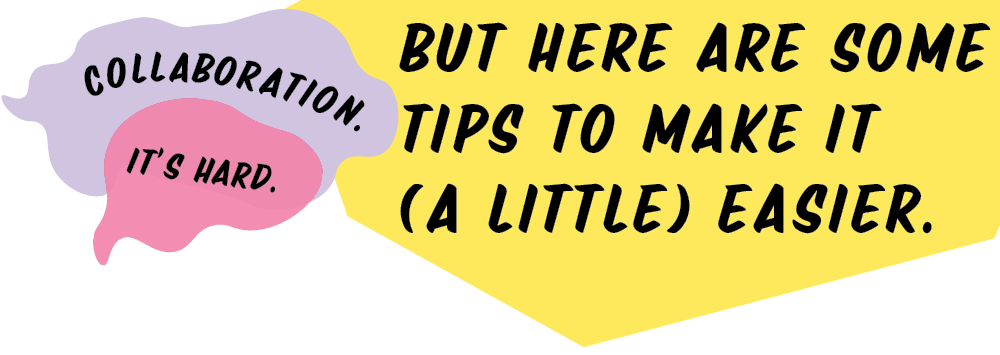
Words by Stephanie Devitt, SDK Communications
Last week, I had the opportunity to join my colleagues Lisa Negstad and Karen DeYoung in partnering with Pollen on their event, #LikeABoss | Collaboration. It’s Hard.
We were proud to bring our passion and experience to the topic, and pair it with first-hand lessons from Minnesota’s top collaborative leaders in art, music, culinary and nonprofit fields. Not to mention Pollen has its own direct experience pushing new boundaries of organizational structure and collaboration. Great wisdom abounded.
Collaboration is a hot topic. Just look here, here, and here.
But for Lisa, Karen, and me, the topic of collaboration grew out of personal experiences. In the fall of 2015, I was leading a challenging change project and faced unexpected hurdles: the sudden death of a client; unscrupulous tactics of a subcontractor I mistakenly trusted. Around the same time, two consulting colleagues we knew were diagnosed with cancer and another former partner faced unexpected challenges with a long-term client after a staffing change.
Turbulence was everywhere, and it brought home the importance of collaboration and connection for each of us as consultants and colleagues.
The experiences kick-started reflection that brought us to Pollen last week, and to a renewed interest in elevating the importance, value, and challenges of collaboration. Here are a few of the trends we’ve seen, shared with the #LikeABoss crowd:
Our Leadership Must Transform To Reflect Our State.
Minnesota’s Latino population has grown by more than 500% since 1990, and the state’s African American population has grown by 300% in the same time period. But for our executive leaders, nonprofit CEOs and elected leaders? The growth in leadership seats has been paltry at best. Karen DeYoung emphasized that collaboration must include new voices and a diversity of perspectives if we’re to reap the full benefits of partnership. That starts with bringing diversity and inclusion into existing institutional leadership, but it also means consciously seeking a variety of perspectives across races, ethnicities and geographies in building the collaborations and “think tanks” that will design the next generation.
Collaborations Are Essential As Organizations Face New Demands And Limited Resources.
Individuals aren’t the only ones being asked to collaborate more and differently in the new economy. Organizations working to tackle wicked and systemic problems simply can’t act alone to be successful. Yet collaboration can be a challenge in resource-strapped environments where partners and competitors are sometimes one in the same.
For the “calcified organizations” I often see—local governments, healthcare providers, schools, and small nonprofits that were expected to de-invest in communications and human connection for decades—these pressures are all the more strenuous. New collaborations and communications systems, both across internal departments and with external partners, are new terrain. Leaders are now being asked to create and manage these new collaborations in narrowly-focused, highly-scrutinized cultures. Yet their public nature makes collaborations even more essential to fulfilling institutional missions.
It’s a hard balance.
Lazerbeak of the Hip Hop collaborative Doomtree noted that finding the right partners can be especially hard, and fit is essential. “People approach us now to add the cool factor, but we don’t always take them up on it. It’s just a vibe…. I don’t want to get overpowered in a collaboration,” he explained.
Panelist DeAnna Cummings of Juxtaposition Arts had a similar perspective: “We’ve had people approach us seeking a ‘collaboration,’ but they’re really looking for someone to apply with them on a grant. We’ve built 20 years of reputation, and don’t give that away easily.”
The New Economy Requires More Than Just Hierarchy.
While Lisa Negstad works with hierarchical organizations, she regularly works with teams and leaders exploring shared leadership and flat organization models, and she sees the trend growing. She pointed out an important stat: 94% of new job creation from 2005 to 2015 was from “alternative work arrangements.” In that environment, the very idea of hierarchy gets tipped on its head as the hierarchy between entities (contractor and consultant, provider and nonprofit) becomes more prominent. New ways of working together must emerge, and collaboration in different forms and shapes will be at the heart.
Deanna had a different take: She believes that hierarchy is essential to keeping things moving. “If everybody is responsible, then nobody is responsible,” she observed.
Panelist Tricia Heuring of Public Functionary believes that “respect, value and trust [in] each other’s work” are the essential ingredients of making flat leadership models work, in her experience.
Perhaps “easier” is a misnomer. But these tips can certainly help to manage expectations, and transform the sting of unknown discomfort into pride-inducing signs of growth.
- Get Comfortable With Discomfort.
“If you’re comfortable, you’re not collaborating.” That was Lisa’s line of the day. Karen offered a similar observation: “Collaboration is a journey, not an event.” And it’s so true. Collaboration requires close enough relationships that you can stand up for what you believe in. But even then, stretching yourself in partnership with others will never be easy. DeAnna pointed out to the group: “Science proves that the results of a collective are always better than the outcomes of even the smartest individual, especially when we’re dealing with big, complex problems. Diverse perspectives—and especially perspectives across racial and ethnic lived experiences—are essential to solving problems. But they’re not always comfortable.” - The House Collaboration Built: A Foundation Of Trust, And Parameters Of Clear Boundaries.
I’ve been working in collaborations, and guiding organizations to build their own, for almost 20 years. The consistent challenge I’ve seen is this balance of trust and boundaries. Often I see a focus on building trust but without boundaries. Quickly relationships can fall victim to issues of ownership, lack of accountability, unnamed tensions that fester, or blurring of professional and personal ties that help work beginning but undercut success in the end. The result of trust without boundaries can be anything from bruised feelings to deeply damaged relationships. No one wants that. - Shared Power Is A Requirement Of True Collaboration.
Discomfort, trust, and boundaries are cornerstones of collaboration’s foundation—and shared power is the pinnacle we all strive for. Karen pointed out that in her work to bring communities of color into leadership roles and public processes, the strategies always aim toward building collaborations where power is shared across races and perspectives. Panelist Heidi Andermack, co-founder of Chowgirls, said that in her co-ownership model, it’s important to step back and “know when to lead and when to follow.” The panel agreed with this idea whole-heartedly—and recognized that this applies doubly so in engaging people across racial, ethnic, and geographic perspectives in taking turns at the helm of leadership.
#LikeABoss gave great insight into the daily realities of collaboration and the bigger trends that brought this topic front-and-center. But I hope that the event can be a springboard to continued conversation on this topic.
We need collaboration now, more than ever:
- To Protect Salaries / Wages In The Social Sector.
Unfortunately, in the five years I have been building out my practice, I’ve seen a “race to the bottom” in some pockets as consultants set prices out of anxiety over where the next job will come from. Nonprofits wrestling with self-confidence, anxiety, pre-existing networks. A culture of anxiety can fester and grow in isolation; or those of us leading work in this space can come together to support and lift each other up. Our future is in our hands, but growth is most possible together. - To Give Everyone A Chance A Foot In The Door.
GREATER MSP’s Make It. MSP. initiative is dedicated to helping the Twin Cities’ newcomers of color find connection here. While corporate-focused, the project’s research highlights what locals have long-known: Minnesota is difficult to “break into” socially. As we move to a world where more and more work is happening through contracts and temporary collaborations, cultivating shared community across professionals will be even more important. Without it, could social isolation translate into growing financial inequality? Available concrete data is thin, but all signs point to yes. - To Make Systemic Change That Will Really Address Tough Problems.
Complex problems require a multitude of perspectives in creating workable, achievable solutions. People from communities traditionally left behind must be given a voice in shaping the new systems for addressing pressing issues and delivering essential services. And yesterday’s organizations shouldn’t be the only voices and electors in determining the shape of tomorrow’s institutions.
We need a new conversation about our social contract as a professional, social sector, while we have the opportunity to rewrite the path of change for equity.
In the months to come, we’ll be working together on a new initiative aimed at connecting and supporting the people and small organizations that make our social sector work. For this exploratory phase, we’re calling it Beta 3 Point 0. Beta, as in this is our first prototype of a concept that we expect to refine and improve. 3 Point 0 as in we’re ready to think about the next generation of organization, unbound by IRS status or traditional hierarchies, to create a modern social contract that ensures everyone has an opportunity for respect, a living, and a life.
Want to join us? Go to Beta3Point0.com to sign up. We’d love to buy you a cup of coffee and hear your perspective, too.


